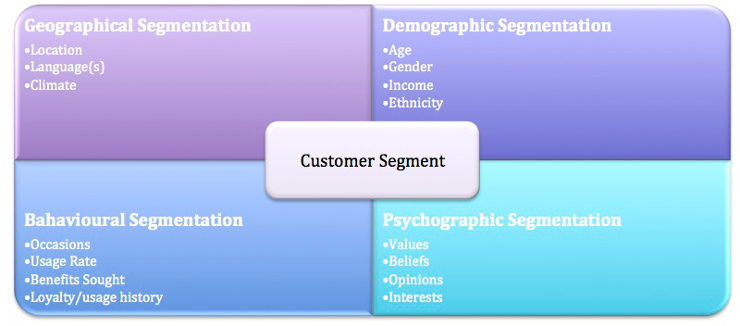Segmentation Basics

There are a number of ways you can differentiate human beings for the purpose of marketing. Here are the big four:
1. Geographical Segmentation
You can group people by any level of geography from Planet Earth to a postcode and anything in-between.
The most obvious reason for determining the geography of a segment is to understand your catchment area, but there might be additional characteristics, for example, the climate in a given region, or its topology. You can’t sell umbrellas if it never rains.
2. Demographic Segmentation
Demographics are people descriptors, for example age, gender, ethnicity, or disposable income. Luxury products need to be targeted at those who can afford them. Some things are prescribed by certain belief systems. Young people rarely need zimmer-frames.
When you combine geographical targeting with demographic targeting you get something called geo-clustering, or as I prefer to put it, the right people in the right place.
3. Psychographic Segmentation
This is the warm and fuzzy stuff to do with personal values, lifestyle and aspirations. It is more about how consumers see themselves, rather than how rigid systems such as geography and demographics would have them be seen. Data like this is usually captured in the form of surveys and polls.
4. Behavioural Segmentation
This looks at the behavioural patterns of current and potential customers and seeks to identify common traits. For example, a hotel will target regular business travellers differently than a family that takes one major holiday a year. Same hotel but different segments based on behaviour.
What validates a segment
A valid segment will meet all of these criteria:
- Measurable – this means you can determine its size and composition and you will also be able to make intelligent predictions about the revenue and profit it can generate.
- Substantial – this refers to profitability not size. A segment might constitute only one customer, but if the profit is significant it may well be viable.
- Differentiable – different segments will react differently to the same marketing mix. If they don’t, they are not different segments.
- Actionable – you should be able to provide the value that this customer seeks. For example, a low-cost airline has little to offer the intercontinental business traveller.
- Accessible – You should be able to reach the segment at an appropriate time and place and in the right context.
If an identified segment does not meet any of these then it is not effective and is highly unlikely to succeed.
Know your segments, know your customer
After considerable brainstorming, you might have identified several segments to which you can deliver competitive value. You have to decide which segments offer the most bang for your buck. You also need to understand whether you would deliver the same product to different segments but perhaps with different packaging and messaging. The hotel I demonstrated in the previous example offers the same rooms to different markets. BMW, on the other hand, builds a range of cars that meet the needs of different segments while maintaining a common brand thread in the form of its core value, the ultimate driving machine.
In the real world
This all might sound very obvious but it never ceases to amaze me how many companies go to market on assumptions that are based on their own world view and not that of their customers.
To be fair, in the real world, there is a lot of intuition that goes into segmentation, especially in the early stages, before there is a customer base that can be polled. For many products, the market(s) might be obvious, but for many companies, it is not so simple. For example, imagine an online sports retailer:
Geographically there may be no restrictions beyond variable shipping costs and customs duties over which they have no control.
Demographically they may offer brands that range in price and appeal to differing levels of disposable income. How can they promote themselves as competitors to Sports Direct and John Lewis at the same time?
In terms of behaviour, sports is a loose term. It can mean anything from darts to football, snooker to skiing. How do they position themselves and in which markets? How do they prioritise? There are many possible answers, none of which are necessarily wrong, but which will produce different outcomes in terms of profitability.
What can you do?
Segmentation is a marketing discipline in its own right and can be a highly complicated undertaking.
However, it never hurts to apply this type of thinking. After all, your customer is the centre of your universe. Anything that helps you understand and connect with them is a good thing. One size does not fit all and rarely does one simple message hit the spot with every potential customer out there.
